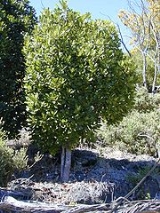
Myrsine lessertiana
Encyclopedia
Kōlea lau nui is a species of colicwood
that is endemic to Hawaii
. It inhabits dry
, coastal mesic, mixed mesic, and wet forests at elevations of 210 – on all main islands. M. lessertiana is a small to medium-sized tree
, reaching a height of 18 m (59.1 ft) and a trunk diameter of 0.3–0.6 m (0.984251968503937–2 ft).
used kōlea lau nui wood to make papa olonā (Touchardia latifolia
scrapers), kua kuku (kapa
anvils), pou (house posts), kaola (beams) and pale (gunwale
s) and manu (ornamental end pieces) for waa (outrigger canoe
s). Kōlea lau nui bark
was boiled in water to make hili kōlea (a red dye
), which was then used on kapa.
Myrsine
Myrsine is a genus of flowering plants, the nominate genus of the family Myrsinaceae. It is found nearly worldwide, primarily in tropical and subtropical areas...
that is endemic to Hawaii
Hawaii
Hawaii is the newest of the 50 U.S. states , and is the only U.S. state made up entirely of islands. It is the northernmost island group in Polynesia, occupying most of an archipelago in the central Pacific Ocean, southwest of the continental United States, southeast of Japan, and northeast of...
. It inhabits dry
Hawaiian tropical dry forests
The Hawaiian tropical dry forests are a tropical dry broadleaf forest ecoregion in the Hawaiian Islands. They cover an area of on the leeward side of the main islands and the summits of Niihau and Kahoolawe. These forests are either seasonal or sclerophyllous. Annual rainfall is less than and...
, coastal mesic, mixed mesic, and wet forests at elevations of 210 – on all main islands. M. lessertiana is a small to medium-sized tree
Tree
A tree is a perennial woody plant. It is most often defined as a woody plant that has many secondary branches supported clear of the ground on a single main stem or trunk with clear apical dominance. A minimum height specification at maturity is cited by some authors, varying from 3 m to...
, reaching a height of 18 m (59.1 ft) and a trunk diameter of 0.3–0.6 m (0.984251968503937–2 ft).
Uses
Native HawaiiansNative Hawaiians
Native Hawaiians refers to the indigenous Polynesian people of the Hawaiian Islands or their descendants. Native Hawaiians trace their ancestry back to the original Polynesian settlers of Hawaii.According to the U.S...
used kōlea lau nui wood to make papa olonā (Touchardia latifolia
Touchardia latifolia
Touchardia latifolia, commonly known as Olonā in Hawaiian, is a species of flowering shrub in the nettle family, Urticaceae. T. latifolia is endemic to Hawaii and inhabits mesic valleys and wet forests at elevations of . Typical to many Hawaiian plants, the olonā does not have any stinging needles...
scrapers), kua kuku (kapa
Kapa
Kapa is a fabric that was made by Native Hawaiians from the bast fibres of certain species of trees and shrubs in the orders Rosales and Malvales. It is similar to tapa found elsewhere in Polynesia but differs in the methods used in its creation...
anvils), pou (house posts), kaola (beams) and pale (gunwale
Gunwale
The gunwale is a nautical term describing the top edge of the side of a boat.Wale is the same word as the skin injury, a wheal, which, too, forms a ridge. Originally the gunwale was the "Gun ridge" on a sailing warship. This represented the strengthening wale or structural band added to the design...
s) and manu (ornamental end pieces) for waa (outrigger canoe
Outrigger canoe
The outrigger canoe is a type of canoe featuring one or more lateral support floats known as outriggers, which are fastened to one or both sides of the main hull...
s). Kōlea lau nui bark
Bark
Bark is the outermost layers of stems and roots of woody plants. Plants with bark include trees, woody vines and shrubs. Bark refers to all the tissues outside of the vascular cambium and is a nontechnical term. It overlays the wood and consists of the inner bark and the outer bark. The inner...
was boiled in water to make hili kōlea (a red dye
Dye
A dye is a colored substance that has an affinity to the substrate to which it is being applied. The dye is generally applied in an aqueous solution, and requires a mordant to improve the fastness of the dye on the fiber....
), which was then used on kapa.

